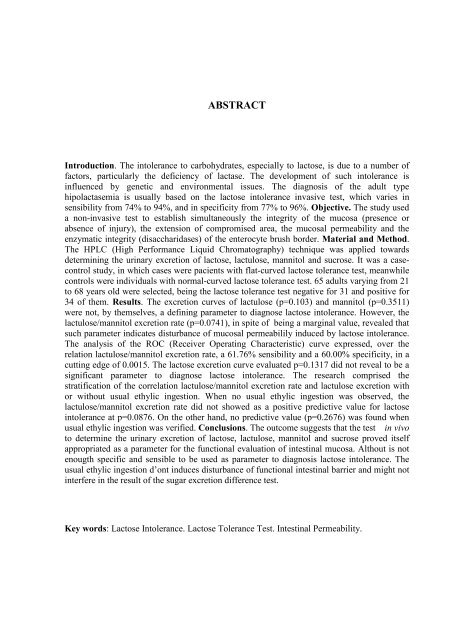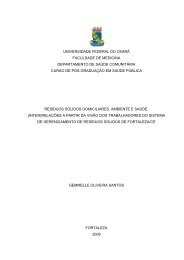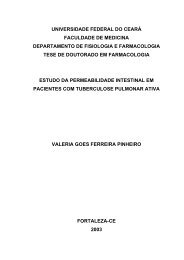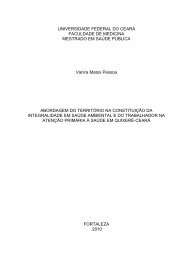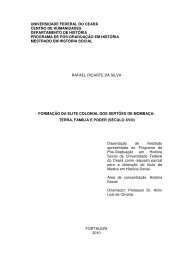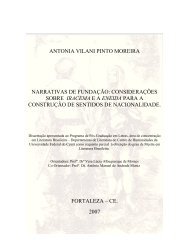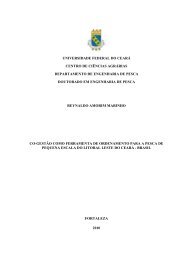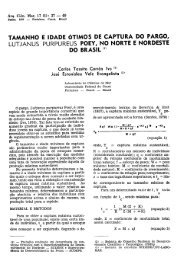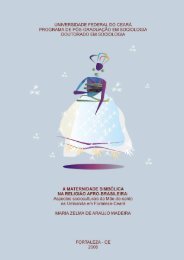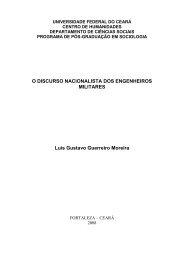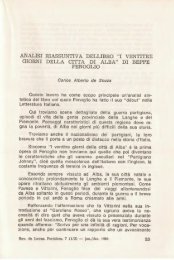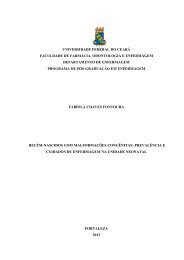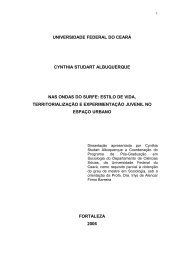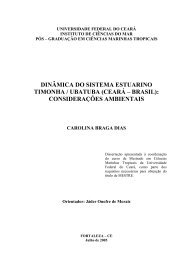ricardo aires - novembro 2008 - correo tese - Repositorio.ufc.br - UFC
ricardo aires - novembro 2008 - correo tese - Repositorio.ufc.br - UFC
ricardo aires - novembro 2008 - correo tese - Repositorio.ufc.br - UFC
You also want an ePaper? Increase the reach of your titles
YUMPU automatically turns print PDFs into web optimized ePapers that Google loves.
ABSTRACT<<strong>br</strong> />
Introduction. The intolerance to carbohydrates, especially to lactose, is due to a number of<<strong>br</strong> />
factors, particularly the deficiency of lactase. The development of such intolerance is<<strong>br</strong> />
influenced by genetic and environmental issues. The diagnosis of the adult type<<strong>br</strong> />
hipolactasemia is usually based on the lactose intolerance invasive test, which varies in<<strong>br</strong> />
sensibility from 74% to 94%, and in specificity from 77% to 96%. Objective. The study used<<strong>br</strong> />
a non-invasive test to establish simultaneously the integrity of the mucosa (presence or<<strong>br</strong> />
absence of injury), the extension of compromised area, the mucosal permeability and the<<strong>br</strong> />
enzymatic integrity (disaccharidases) of the enterocyte <strong>br</strong>ush border. Material and Method.<<strong>br</strong> />
The HPLC (High Performance Liquid Chromatography) technique was applied towards<<strong>br</strong> />
determining the urinary excretion of lactose, lactulose, mannitol and sucrose. It was a casecontrol<<strong>br</strong> />
study, in which cases were pacients with flat-curved lactose tolerance test, meanwhile<<strong>br</strong> />
controls were individuals with normal-curved lactose tolerance test. 65 adults varying from 21<<strong>br</strong> />
to 68 years old were selected, being the lactose tolerance test negative for 31 and positive for<<strong>br</strong> />
34 of them. Results. The excretion curves of lactulose (p=0.103) and mannitol (p=0.3511)<<strong>br</strong> />
were not, by themselves, a defining parameter to diagnose lactose intolerance. However, the<<strong>br</strong> />
lactulose/mannitol excretion rate (p=0.0741), in spite of being a marginal value, revealed that<<strong>br</strong> />
such parameter indicates disturbance of mucosal permeabilily induced by lactose intolerance.<<strong>br</strong> />
The analysis of the ROC (Receiver Operating Characteristic) curve expressed, over the<<strong>br</strong> />
relation lactulose/mannitol excretion rate, a 61.76% sensibility and a 60.00% specificity, in a<<strong>br</strong> />
cutting edge of 0.0015. The lactose excretion curve evaluated p=0.1317 did not reveal to be a<<strong>br</strong> />
significant parameter to diagnose lactose intolerance. The research comprised the<<strong>br</strong> />
stratification of the correlation lactulose/mannitol excretion rate and lactulose excretion with<<strong>br</strong> />
or without usual ethylic ingestion. When no usual ethylic ingestion was observed, the<<strong>br</strong> />
lactulose/mannitol excretion rate did not showed as a positive predictive value for lactose<<strong>br</strong> />
intolerance at p=0.0876. On the other hand, no predictive value (p=0.2676) was found when<<strong>br</strong> />
usual ethylic ingestion was verified. Conclusions. The outcome suggests that the test in vivo<<strong>br</strong> />
to determine the urinary excretion of lactose, lactulose, mannitol and sucrose proved itself<<strong>br</strong> />
appropriated as a parameter for the functional evaluation of intestinal mucosa. Althout is not<<strong>br</strong> />
enougth specific and sensible to be used as parameter to diagnosis lactose intolerance. The<<strong>br</strong> />
usual ethylic ingestion d’ont induces disturbance of functional intestinal barrier and might not<<strong>br</strong> />
interfere in the result of the sugar excretion difference test.<<strong>br</strong> />
Key words: Lactose Intolerance. Lactose Tolerance Test. Intestinal Permeability.<<strong>br</strong> />
7


